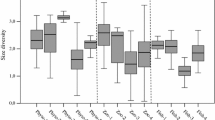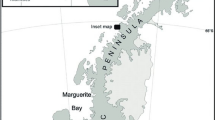Abstract
We studied the relationship between particle-size selectivity and variable particle-size distribution in the American mud snail Hydrobia totteni Morrison (Prosobranchia: Hydrobiidae) collected in the summer of 1979 and 1982, from saltmarsh mudflats at Flax Pond, Old Field, New York, USA. Using individual size fractions of native sediment, snails fed fastest on intermediate-sized particles (41 to 63 μm); this pattern was related to diatom abundance, which was similarly greatest on the intermediate particle-size classes. These results conform to another study, which found a quite different relationship between feeding rate and particle size, but a similarly strong correlation between particle size and diatom abundance. Snails were fed a range of particle-size distributions of glass beads. As median particle size increased, preference shifted towards smaller particles. This shift cannot be explained by feeding rates determined from individual particle-size classes. The most reasonable alternative model is a shift towards feeding on fine particles that occur among the coarser particles that are not ingested. Our data suggest that diatom growth on certain particle sizes is as important to particle selectivity as the particle sizes themselves. Particle size preference cannot be extrapolated from studies of feeding rates on individual size classes since selectivity is qualitatively different in mixtures of various size classes.
Similar content being viewed by others
Literature cited
Bianchi, T. S., Levinton, J. S. (1984). The importance of microalgae, bacteria and particulate organic matter in the somatic growth of Hydrobia totteni. J. mar. Res. 42: 431–443
Cammen, L. M. (1982). Effect of particle size on organic content and microbial abundance within four marine sediments. Mar. Ecol. Prog. Ser. 9: 273–280
Cherrill, A. J., James, R. (1987). Character displacement in Hydrobia. Oecologia 71: 618–623
Chesson, J. (1978). Measuring preference in selective predation. Ecology 59: 211–215
Fenchel, T. (1970). Studies on the decomposition of organic detritus derived from the turtle grass Thallassia testudinum. Limnol. Oceanogr. 15: 14–20
Fenchel, T. (1975a). Factors determining the distribution patterns of mud snails (Hydrobiidae). Oecologia 20: 1–17
Fenchel, T. (1975b). Character displacement and coexistence in mud snails. Oecologia 20: 19–32
Fenchel, T., Kofoed, L. H. (1976). Evidence for exploitative interspecific competition in mud snails (Hydrobiidae). Oikos 27: 367–376
Hargrave, B. T. (1970). The utilizatio of benthic microflora by Hyallela azteca (Amphipoda). J. Anim. Ecol. 35: 427–437
Hughes, T. G. (1973). Deposit feeding in Abra tenuis (Bivalvia: Tellinacca). J. Zool., Lond. 171: 499–512
Ivlev, V. S. (1961). Experimental ecology of the feeding of fishes. Yale University Press, New Haven, Connecticut
Kofoed, L. H. (1975). The feeding biology of Hydrobia ventrosa Montagu. I. The assimilation of different components of the food. J. exp. mar. Biol. Ecol. 19: 233–241
Levinton, J. S. (1980). Particle feeding by deposit feeders: models, data, and a prospectus. In: Tenore, K. R., Coull, B. C. (eds.) Marine Benthic Dynamics. University of South Carolina Press, Columbia, South Carolina, p. 423–429
Levinton, J. S. (1982). The body size-prey size hypothesis: the adequacy of body size as a vehicle for character displacement. Ecology 63: 869–872
Levinton, J. S. (1987). The body size-prey size hypothesis and Hydrobia. Ecology 68: 229–231
Levinton, J. S., Bianchi, T. S. (1981). Nutrition and food limitation of deposit-feeders. I. The role of microbes in the growth of mud snails (Hydrobiidae). J. mar. Res. 39: 531–545
Levinton, J. S., Lopez, G. R. (1977). A model of renewable resources and control of deposit feeding benthic populations. Oecologia 31: 177–190
Levinton, J. S., Stewart, S., DeWitt, T. H. (1985). Complex interactions of a deposit feeder with its resources. 2. Field and laboratory experiments on interference between Hydrobia totteni and Ilyanassa obsoleta (Gastropoda) and its possible relationship to seasonal shifts in vertical zonation on mudflats. Mar. Ecol. Prog. Ser. 22: 53–58
Lopez, G. R., Kofoed, L. H. (1980). Epipsammic browsing and deposit-feeding in mud snails (Hydrobiidae). J. mar. Res. 38: 585–599
Lopez, G. R., Levinton, J. S. (1978). The availability of microorganisms attached to sediment particles as food for Hydrobia ventrosa. Oecologia 32: 263–275
Newell, R. C. (1965). The role of detritus in the nutrition of two marine deposit feeders, the prosobranch Hydrobia ulvae and the bivalve Macoma balthica. Proc. zool. Soc. Lond. 144: 25–45
Taghon, G. L. (1981). Beyond selection: optimal ingestion rate as a function of food value. Am. Nat. 118: 202–214
Taghon, G. L., Jumars, P. A. (1984). Variable ingestion rate and its role in optimal foraging behavior of marine deposit feeders. Ecology 65: 549–558
Whitlatch, R. B. (1974). Food-resource partitioning in the deposit-feeding polychaete Pectinaria gouldii. Biol. Bull. mar. biol. lab, Woods Hole 147: 227–235
Author information
Authors and Affiliations
Additional information
Communicated by J. P. Grassle, Woods Hole
Rights and permissions
About this article
Cite this article
Levinton, J.S., DeWitt, T.H. Relation of particle-size spectrum and food abundance to particle selectivity in the mud snail Hydrobia totteni (Prosobranchia: Hydrobiidae). Mar. Biol. 100, 449–454 (1989). https://doi.org/10.1007/BF00394821
Accepted:
Issue Date:
DOI: https://doi.org/10.1007/BF00394821




